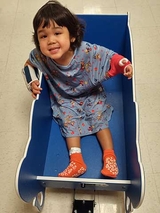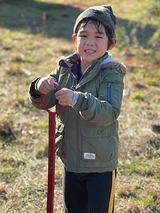Brachial Plexus Injury: Cai Li’s Story
Brachial Plexus Injury: Cai Li’s Story
Even before Cai Li’s parents brought him home from the orphanage in China, they knew he had at least one medical issue – a brachial plexus injury. Due to incomplete medical records at the orphanage, they weren’t certain of the nature or severity of the issue or how it might impact his growth and development. His parents met proactively with medical experts at Children’s Hospital of Philadelphia (CHOP) where the toddler received needed surgery and occupational therapy to strengthen and develop his arm.

“We knew he had a brachial plexus injury, but not much beyond that, including the cause,” recalled his dad, Shawn. Brachial plexus injuries involve tearing, stretching or compression of the nerves that serve the shoulder and arm. In young children, these injuries are most often caused during birth.
Before Cai arrived in the U.S., Shawn and Daniella had already consulted with a doctor at CHOP. They reviewed the medical records the orphanage shared with the couple to determine what tests and treatment their son might need, as well as to help him adjust to his new home and environment.
Brachial plexus birth injuries can vary in severity: sometimes healing on their own, sometimes requiring surgery. In both cases, early intervention is always preferred to speed the healing process. But Cai’s family had no idea how much therapy – if any – he’d received since his injury or even when the injury occurred.
A new home, and a new treatment plan for brachial plexus injury
Soon after Cai arrived at his new home in South Jersey, his parents brought him to CHOP for an evaluation. At 2 years old, he had very limited movement in his left arm – he could only raise his hand to roughly waist-level, couldn’t rotate his hand and had a very weak grip. For the most part, he had learned to do most things using only his right hand and arm.
About Brachial Plexus Injuries
Cai was seen by Apurva S. Shah, MD, MBA, Co-Director of the Brachial Plexus Injury Program and an attending pediatric orthopedic surgeon who specializes in pediatric hand and upper extremity surgery. Dr. Shah confirmed the diagnosis of a brachial plexus injury, sometimes referred to as an Erb’s palsy.
As a first step, Dr. Shah recommended the toddler begin weekly occupational therapy (OT) sessions to teach him how to use both arms as functionally as possible. The goal was to increase Cai’s overall arm mobility and help him understand how to use both hands for two-handed tasks.
Surgery to improve arm function

While Cai made significant progress through OT, after a year Dr. Shah felt there was more room for improvement. After a discussion with Cai’s parents, Dr. Shah performed a shoulder tendon transfer and contracture release operation to move muscle tissue from Cai’s back to his shoulder and arm to provide additional strength and stability.
“He has gained so much movement from the surgery,” said Shawn. “He can raise his arm and touch the top of his head. His doctors have said Cai exceeded all expectations they had for him based on his initial condition.”
“If I had to grade our experience with CHOP on a 1 to 10 scale, it’s infinity,” said Shawn. “I can’t say enough good things about how they’ve helped. We’re beyond satisfied.”
Continued OT to bolster gains from surgery

Two years after surgery, Cai continues with occupational therapy to build on the gains achieved through surgery and help him improve his arm’s mobility and flexibility. Two key goals of his current OT regimen: improving his ability to rotate his hand (for example, to be able to turn it so he can use a keyboard) and strengthening his grip. Depending on how much progress he can make with OT, another surgery may be in his future.
To keep Cai from experiencing “OT fatigue” his therapist, Meagan Pehnke, MS, OTR/L, CHT, CLT, helped his parents devise a natural OT program he could do largely at home in the course of his daily activities, combined with visits to CHOP every two to three months so she can monitor his progress.
“Cai’s parents have played a significant role in his progress,” Pehnke says. “They keep him very active with sports and outdoor activities that motivate and challenge him to use his left arm and hand in a functional way, so it felt less like structured therapy.”
Shawn adds: “Being able to basically do OT at home means Cai gets to be just a regular kid and do the same things we do. We never treated him like his arm couldn’t do something.”